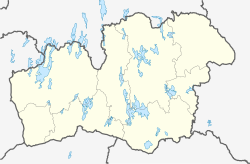Wexio
| Växjö, Sweden | ||
|---|---|---|
|
||
| Coordinates: 56°52′37″N 14°48′33″E / 56.87694°N 14.80917°ECoordinates: 56°52′37″N 14°48′33″E / 56.87694°N 14.80917°E | ||
| Country | Sweden | |
| Province | Småland | |
| County | Kronoberg County | |
| Municipality | Växjö Municipality | |
| Area | ||
| • City | 30.28 km2 (11.69 sq mi) | |
| Elevation | 167 m (548 ft) | |
| Population (31 December 2015) | ||
| • City | 65,345 | |
| • Density | 2,011/km2 (5,210/sq mi) | |
| • Metro | 88,108 | |
| Time zone | CET (UTC+1) | |
| • Summer (DST) | CEST (UTC+2) | |
| Postal code | 35x xx | |
| Area code(s) | (+46) 47 | |
| Website | www |
|
Växjö ([²vɛkːɧøː]) is a city and the seat of Växjö Municipality, Kronoberg County, Sweden. It had 63,479 inhabitants as of 2013[update], out of a municipal population of 85,000. It is the administrative, cultural, and industrial centre of Kronoberg County and the episcopal see of the Diocese of Växjö. The town is home to Linnaeus University.
The city's name is believed to be constructed from the words "väg" (road) and "sjö" (lake), meaning the road over the frozen Växjö Lake that farmers used in the winter to get to the marketplace which later became the city.
In contrast to what was believed a century ago, there is no evidence of a special pre-Christian significance of the site. The pagan cultic center of Värend may have been located at Hov, a nearby village.
An episcopal see since the 12th century, the city did not get its city charter until 1342, when it was issued by Magnus Eriksson. During the Middle Ages, Växjö did not have many pious institutions. A Franciscan monastery was established in 1485. An hospital of the Holy Ghost was first mentioned in 1318. In the 14th century Växjö got its first school, Växjö katedralskola. In 1643 it received gymnasium status.
...
Wikipedia



